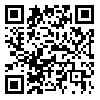Volume 1, Issue 3 (9-2025)
2025, 1(3): 51-61 |
Back to browse issues page
Ethics code: IR.MEDILAM.REC.1403.107
Download citation:
BibTeX | RIS | EndNote | Medlars | ProCite | Reference Manager | RefWorks
Send citation to:



BibTeX | RIS | EndNote | Medlars | ProCite | Reference Manager | RefWorks
Send citation to:
Najafi F, Najafi R, jaafarpour M, Jafarpour A A, Vasiee A. Determining the Relationship between Learning Styles and Mental Vitality in Nursing and Midwifery Students. Journal of Health Sciences Perspective 2025; 1 (3) :51-61
URL: http://jhsp.medilam.ac.ir/article-1-37-en.html
URL: http://jhsp.medilam.ac.ir/article-1-37-en.html
Department of Nursing, Faculty of Nursing and Midwifery, Ilam University of Medical Sciences, Ilam, Iran
Abstract: (356 Views)
Introduction: The main goal of an education system in any country is to facilitate learning, influenced by factors such as intelligence, motivation, supportive environments, family and social dynamics, educational standards, and the quality of teachers. This research investigated the relationship between learning styles and the mental well-being of students in nursing and midwifery programs.
Materials & Methods: In 2024, 194 nursing and midwifery students at Ilam University of Medical Sciences participated in this cross-sectional study. The VARK Learning Styles Questionnaire, the Subjective Vitality Scale (SVS), and a demographic form were employed to gather data. The questionnaires were submitted by all participants, who met the inclusion criteria. The instruments' validity and reliability were verified in previous research. Using descriptive statistics, correlation tests, and multiple linear regression with a significance level of p < 0.05, the data were analyzed in SPSS version 22.
Results: A significant proportion of students exhibited a dominant learning style characterized by visual preferences, accounting for 31.4% of the population. The subsequent styles were reading/writing, auditory, and kinesthetic. The average score of students' mental vitality was 25.65, accompanied by a standard deviation of 4.20, suggesting a relatively positive level of mental vitality among the participants. The most significant correlation between mental vitality and visual style was observed (r = 0.39), followed by kinesthetic, auditory, and reading/writing styles in that order.
Conclusion: Medical education system administrators are advised to consider students' chosen learning styles and provide training for professors via educational workshops to transform existing methodologies and enhance students' cognitive engagement.
Materials & Methods: In 2024, 194 nursing and midwifery students at Ilam University of Medical Sciences participated in this cross-sectional study. The VARK Learning Styles Questionnaire, the Subjective Vitality Scale (SVS), and a demographic form were employed to gather data. The questionnaires were submitted by all participants, who met the inclusion criteria. The instruments' validity and reliability were verified in previous research. Using descriptive statistics, correlation tests, and multiple linear regression with a significance level of p < 0.05, the data were analyzed in SPSS version 22.
Results: A significant proportion of students exhibited a dominant learning style characterized by visual preferences, accounting for 31.4% of the population. The subsequent styles were reading/writing, auditory, and kinesthetic. The average score of students' mental vitality was 25.65, accompanied by a standard deviation of 4.20, suggesting a relatively positive level of mental vitality among the participants. The most significant correlation between mental vitality and visual style was observed (r = 0.39), followed by kinesthetic, auditory, and reading/writing styles in that order.
Conclusion: Medical education system administrators are advised to consider students' chosen learning styles and provide training for professors via educational workshops to transform existing methodologies and enhance students' cognitive engagement.
Type of Study: Research |
Subject:
Theory-based health education
Received: 2025/04/12 | Accepted: 2025/09/10 | Published: 2025/09/15
Received: 2025/04/12 | Accepted: 2025/09/10 | Published: 2025/09/15
Send email to the article author
| Rights and permissions | |
 |
This work is licensed under a Creative Commons Attribution-NonCommercial 4.0 International License. |





